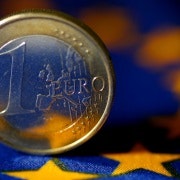The mid-sized duo flipping European wisdom
Pay close attention to the European economic figures that came out last week and look behind the headline news that the eurozone as a whole is out of recession. Your reward will be a tale of two countries that shows how stubbornly Europe’s economy is ignoring the script from which its politicians have been preaching.
They are Portugal and the Netherlands: mid-sized countries emblematic of the monetary union’s 'south' and 'north', or 'periphery' and 'core'. They are at opposite ends of an axis that sceptics see as the euro’s congenital flaw: the asymmetry between competitive rich countries, which a fixed exchange rate turned into structural savers, and their uncompetitive poor cousins whose inveterate overspending the euro just made worse.
Throughout the euro era, Portugal has had large budget deficits, hitting double digits as a share of annual output at the height of the crisis. The country did not even enjoy the unsustainable boom that got Greece, Spain, and Ireland into trouble. The Portuguese economy only shuffled through the euro’s first decade. It is now nursing a bad hangover without ever having been to the party.
Contrast with the Dutch. They have out-teutonised the Germans on many metrics that define Germany’s frugal, export-led economic model. The current account has been more positive in the Netherlands than in Germany almost every year of the euro’s existence. The Dutch public deficit was consistently smaller than the German one before the crisis. In their view of economic policy, too, the Dutch often outdo the Germans, insisting more loudly than Berlin on painful deficit cuts in Portugal and other deficit states as the price they have to pay for financial rescues.
According to the morality play guiding the European Commission and the creditor economies that steer eurozone policy, the Dutch will be rewarded with economic success and Portugal condemned to financial purgatory until cleansed of its sins. The alternative fable told by sceptics of the monetary union says these nations should never have shared a currency, and their different prospects are as ineluctable as the permanent north-south transfers that will be needed to keep the euro together.
And so things have looked until recently. But Europe’s economy is more complex than the stories admit. As if it wanted to make a point, it has begun to go off-message.
In the second quarter, Portugal grew at an annualised rate of 4.5 per cent – the fastest of any EU country. The Netherlands kept shrinking, by 0.2 per cent in the last quarter (0.8 per cent on an annualised basis).
One should be careful to draw firm lessons from one quarter’s data. Portugal’s growth spurt no doubt reflects one-off factors more than a change of trend. Still, the contrast serves to illustrate how impoverished the most common stories told about the eurozone really are.
Against those who preach fiscal discipline above all else, the Dutch recession shows that neither solid public finances nor (this is even less commonly appreciated) large current account surpluses are sufficient to prevent credit bubbles that bring the economy down when they burst. The Dutch are suffering the consequences of an entirely self-inflicted housing bubble. The household debt-to-income ratio is 250 per cent. House prices have fallen by 21 per cent. This makes overstretched homeowners – 30 per cent owe more than their house is worth – consume less. Add public deficit cuts, which the Dutch imposed on themselves in their enthusiasm for a fiscal compact to bind the Portuguese and others, and a depressed economy is the unavoidable consequence.
This is but a milder version of what has been happening in Ireland and Spain. While current account deficits helped fuel the bubble in those countries, the Netherlands shows that a net creditor economy can mess up its housing market too. In other words, the crisis in many euro countries has more to do with bad domestic credit regulation than with the capital imbalances between them, though these indisputably encouraged bad domestic policy.
The bright side to this is that the euro is not as flawed as all that. Asymmetric capital flows are not incompatible with healthy economies – private sector lending from richer economies to poorer ones is to be desired – but such credit must fund productive investment. That requires better banks. After trying everything else first, eurozone leaders are finally starting to address the real problem.
Copyright The Financial Times Limited 2013













